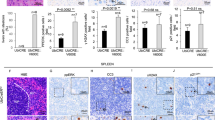Abstract
Alterations in signalling via the Raf/MEK/ERK pathway interfere with influenza A virus replication in cell culture. While virus yields are reduced in cells expressing dominant-negative Raf or ERK, virus propagation is enhanced upon expression of constitutively active Raf or MEK. To study the impact of active Raf on influenza virus propagation in vivo, we investigated transgenic mice expressing an activated mutant of c-Raf (Raf-BxB) in the main target tissue of influenza virus, the lung. Raf-BxB expression results in multicentric alveolar adenomas. Influenza virus A infection of Raf-BxB mice results in increased disease symptoms and higher mortality rates. The immune response against viral pathogens in transgenic animals did not differ from wild-type mice as determined by the use of a Pseudorabies virus (PRV) as a model for a viral infection not affecting the lung. No significant differences of influenza virus titers in the lung of Raf-BxB and wild-type mice were observed. However, immunohistology revealed increased numbers of influenza NP-positive cells in the alveolar linings of Raf-BxB mice, demonstrating the strong tropism of influenza virus for cells expressing active Raf. These findings disclose the possibility to use modified influenza virus for the therapy of tumors with an activated Ras/Raf signalling pathway.
This is a preview of subscription content, access via your institution
Access options
Subscribe to this journal
Receive 50 print issues and online access
$259.00 per year
only $5.18 per issue
Buy this article
- Purchase on Springer Link
- Instant access to full article PDF
Prices may be subject to local taxes which are calculated during checkout






Similar content being viewed by others
References
Anderson H, Petrie K, Berrisford C, Charlett A, Thatcher N and Zambon M . (1999). Br. J. Cancer, 80, 219–220.
Arrowood JR and Hayney MS . (2002). Ann. Pharmacother., 36, 1219–1229.
Bergmann M, Romirer I, Sachet M, Fleischhacker R, Garcia-Sastre A, Palese P, Wolff K, Pehamberger H, Jakesz R and Muster T . (2001). Cancer Res., 61, 8188–8193.
Bos JL . (1989). Cancer Res., 49, 4682–4689.
Brydak LB and Machala M . (2000). Drugs, 60, 35–53.
Card JP and Enquist LW . (1995). Crit. Rev. Neurobiol., 9, 137–162.
Couch RB, Englund JA and Whimbey E . (1997). Am. J. Med., 102, 2–9.
Fischer T, Planz O, Stitz L and Rziha HJ . (2003). J. Virol., 77, 9312–9323.
Hall WJ, Douglas Jr RG, Hyde RW, Roth FK, Cross AS and Speers DM . (1976). Am. Rev. Respir. Dis., 113, 141–148.
Kerkhoff E, Fedorov LM, Siefken R, Walter AO, Papadopoulos T and Rapp UR . (2000). Cell Growth Differ., 11, 185–190.
Korfhagen TR, Glasser SW, Wert SE, Bruno MD, Daugherty CC, McNeish JD, Stock JL, Potter SS and Whitsett JA . (1990). Proc. Natl. Acad. Sci. USA, 87, 6122–6126.
Little JW, Hall WJ, Douglas Jr RG, Hyde RW and Speers DM . (1976). Ann. Intern. Med., 85, 177–182.
Ludwig S, Ehrhardt C, Neumeier ER, Kracht M, Rapp UR and Pleschka S . (2001). J. Biol. Chem., 276, 10990–10998.
Ludwig S, Engel K, Hoffmeyer A, Sithanandam G, Neufeld B, Palm D, Gaestel M and Rapp UR . (1996). Mol. Cell. Biol., 16, 6687–6697.
Ludwig S, Planz O, Pleschka S and Wolff T . (2003). Trends Mol. Med., 9, 46–52.
Marshall M . (1995). Mol. Reprod. Dev., 42, 493–499.
Mercer KE and Pritchard CA . (2003). Biochim. Biophys. Acta, 1653, 25–40.
Naumann U, Eisenmann-Tappe I and Rapp UR . (1997). Recent Results Cancer Res., 143, 237–244.
Ober BT, Summerfield A, Mattlinger C, Wiesmuller KH, Jung G, Pfaff E, Saalmuller A and Rziha HJ . (1998). J. Virol., 72, 4866–4873.
Olshaker JS . (2003). Emerg. Med. Clin. North Am., 21, 353–361.
Palese P, Zheng H, Engelhardt OG, Pleschka S and Garcia-Sastre A . (1996). Proc. Natl. Acad. Sci. USA, 93, 11354–11358.
Peschke T, Bender A, Nain M and Gemsa D . (1993). Immunobiology, 189, 340–355.
Pleschka S, Wolff T, Ehrhardt C, Hobom G, Planz O, Rapp UR and Ludwig S . (2001). Nat. Cell Biol., 3, 301–305.
Porter DD and Porter HG . (1999). Clin. Infect. Dis., 29, 437–440.
Ramakrishna G, Sithanandam G, Cheng RY, Fornwald LW and Smith GT . (2000). Exp. Lung Res., 26, 659–671.
Scholtissek C . (1997). Arch. Virol. Suppl., 13, 99–103.
Steinhauer DA and Skehel JJ . (2002). Annu. Rev. Genet., 36, 305–332.
von Gise A, Lorenz P, Wellbrock C, Hemmings B, Berberich-Siebelt F, Rapp UR and Troppmair J . (2001). Mol. Cell. Biol., 21, 2324–2336.
Wurzer WJ, Planz O, Ehrhardt C, Giner M, Silberzahn T, Pleschka S and Ludwig S . (2003). EMBO J., 22, 2717–2728.
Acknowledgements
We thank Katja Oesterle for great technical assistance. This work was supported in part by the Deutsche Forschungsgemeinschaft and by the EU network of excellence Virgil.
Author information
Authors and Affiliations
Corresponding author
Rights and permissions
About this article
Cite this article
Ölschläger, V., Pleschka, S., Fischer, T. et al. Lung-specific expression of active Raf kinase results in increased mortality of influenza A virus-infected mice. Oncogene 23, 6639–6646 (2004). https://doi.org/10.1038/sj.onc.1207883
Received:
Revised:
Accepted:
Published:
Issue Date:
DOI: https://doi.org/10.1038/sj.onc.1207883
Keywords
This article is cited by
-
Functional variants regulating LGALS1 (Galectin 1) expression affect human susceptibility to influenza A(H7N9)
Scientific Reports (2015)
-
A comprehensive map of the influenza A virus replication cycle
BMC Systems Biology (2013)
-
Hair growth promoting effect of essence manufactured with products fermented by Lactobacillus rhamnosus and Backryeoncho (Opuntia ficus-indica var. sarboten) fruits in mice
Food Science and Biotechnology (2012)
-
Higher polymerase activity of a human influenza virus enhances activation of the hemagglutinin-induced Raf/MEK/ERK signal cascade
Virology Journal (2007)
-
In vivo functions of mitogen-activated protein kinases: conclusions from knock-in and knock-out mice
Transgenic Research (2007)



